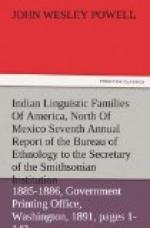bordered by Siouan territory, while the Washaki occupied
southwestern Wyoming. Nearly the entire mountainous
part of Colorado was held by the several bands of
the Ute, the eastern and southeastern parts of the
State being held respectively by the Arapaho and Cheyenne
(Algonquian), and the Kaiowe (Kiowan). To the
southeast the Ute country included the northern drainage
of the San Juan, extending farther east a short distance
into New Mexico. The Comanche division of the
family extended farther east than any other.
According to Crow tradition the Comanche formerly
lived northward in the Snake River region. Omaha
tradition avers that the Comanche were on the Middle
Loup River, probably within the present century.
Bourgemont found a Comanche tribe on the upper Kansas
River in 1724.[82] According to Pike the Comanche
territory bordered the Kaiowe on the north, the former
occupying the head waters of the upper Red River,
Arkansas, and Rio Grande.[83] How far to the southward
Shoshonean tribes extended at this early period is
not known, though the evidence tends to show that they
raided far down into Texas to the territory they have
occupied in more recent years, viz, the extensive
plains from the Rocky Mountains eastward into Indian
Territory and Texas to about 97 deg.. Upon the
south Shoshonean territory was limited generally by
the Colorado River. The Chemehuevi lived on both
banks of the river between the Mohave on the north
and the Cuchan on the south, above and below Bill
Williams Fork.[84] The Kwaiantikwoket also lived to
the east of the river in Arizona about Navajo Mountain,
while the Tusayan (Moki) had established their seven
pueblos, including one founded by people of Tanoan
stock, to the east of the Colorado Chiquito.
In the southwest Shoshonean tribes had pushed across
California, occupying a wide band of country to the
Pacific. In their extension northward they had
reached as far as Tulare Lake, from which territory
apparently they had dispossessed the Mariposan tribes,
leaving a small remnant of that linguistic family
near Fort Tejon.[85]
[Footnote 79: Allen ed.,
Philadelphia, 1814, vol. 1, p. 418.]
[Footnote 80: U.S.
Ind. Aff., 1869, p. 289.]
[Footnote 81: Stevens
in Pac. R. R. Rep., 1855, vol. 1, p. 329.]
[Footnote 82: Lewis and
Clarke, Allen ed., 1814, vol. 1, p. 34.]
[Footnote 83: Pike, Expl.
to sources of the Miss., app. pt. 3, 16,
1810.]
[Footnote 84: Ives, Colorado
River, 1861, p. 54.]
[Footnote 85: Powers
in Cont. N.A. Eth., 1877, vol. 3, p. 369.]
A little farther north they had crossed the Sierras
and occupied the heads of San Joaquin and Kings Rivers.
Northward they occupied nearly the whole of Nevada,
being limited on the west by the Sierra Nevada.
The entire southeastern part of Oregon was occupied
by tribes of Shoshoni extraction.
PRINCIPAL TRIBES AND POPULATION.




